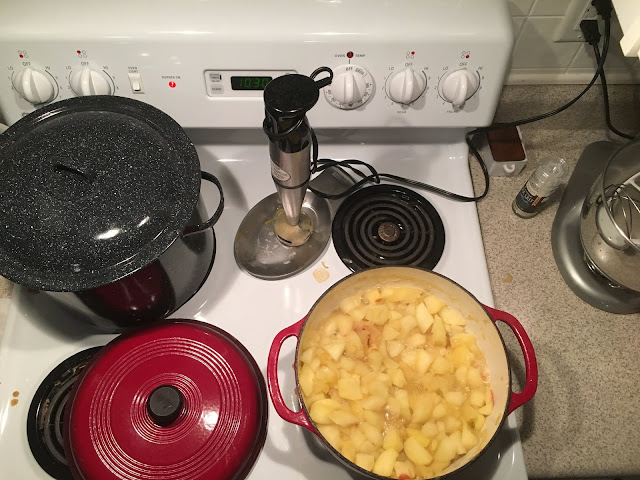Like many people in the northeastern part of the United States, fall not only ushers in the magnificent colors but there is also the outdoor activities such as apple picking. Fortunately we live only 10 minutes away from the best apple farm in the area, Beak and Skiff. Over the last few years the farm has grown significantly to wear it has a bakery, a brewery, and a restaurant. Every fall we find ourselves going to the farm for more than just apple picking. The kids also enjoy the playground surrounded by apple trees and great views. For the parents its a great place to hang around, socialize, and drink something good.
The last time I made applesauce was over 2 years ago and unfortunately that experience wasn't that great because I added to much salt to the sauce and we threw away several pints. The learning experience went a long way.
Beak and Skiff has a variety of apples to pick and this year I decided to experiment with different apples. The first apple in season that interested me was the Empire. According to the description on the picking schedule it is great for eating, making sauce and picked in early October. We spent out first apple pick with friends who have never been to Beak and Skiff.
All of our kids love the picking part but carrying their bag back to the registers always fails. We picked about 35 pounds of apples for eating and sauce.
I generally like to have at least two different apple types in the sauce so I had to wait a couple weeks before the Ruby Frost and Fuji were in season. Fuji is described as great for eating, making sauce, and baking. Ruby Frost was new to my taste buds, but when I sampled it was an instant favorite. The best way to describe the first impression is very juicy, light tart, with a mild sweetness. The website describes the Ruby as great for eating, sauce, baking and salads.
I ended up picking one full bag of each kind. I made sure I got some smaller ones for eating.
Now that the easy part was done, the next few steps take a lot more time. It takes a lot of apples to make a small amount of applesauce.
BATCH #1: Empire (13 apples) and Fuji (13 apples)
BATCH #2: Fuji (12 apples) and Ruby Frost (12 apples)
BATCH #3: Ruby Frost (10 apples)
The reason that I made three different batches was because I picked a lot of apples.
Once the apples are peeled, I chopped them into the dutch oven I use for jams. I make sure its full to the brim and then some because as soon as the apples warm up, the pot becomes half empty. For the first few minutes, the heat is on high with the lid on until the juices at the bottom come to a boil and then the heat was turned down to medium. I also make sure to remove the lid to allow for some water evaporation. Make sure to stir the apples every 5-10 minutes to prevent burning.
I allow them to cook until most of the apples are soft and falling apart. Then I turn off the heat and use a soup mixer and blend the apples to a fine applesauce consistency. One could blend them a lot less and make a nice apple jam thickness. To make jam I would cook it for a little longer, to get rid of more water.
Once blended I added 2-4 tablespoons of organic lemon juice. I used the Santa Cruz this time and I like the results. I use lemon in all of my sauces and jams because it has natural pectin which helps to thicken the fruit and it also has natural preservative properties that will allow for the food to not spoil as quickly.
Unless a tarty applesauce is preferred no other things need to be added at this time.
My family likes to have a little sweetness in the sauce and my favorite sweetener is honey. We use honey that is derived from our family's beehive and therefore its readily available all year round. Honey is best added when the sauce is around 115 degrees Fahrenheit in order to preserve all of the natural properties of the sweet goodness. Unfortunately I didn't have the patience to wait that long so instead I waited until the temperature dropped to about 150 degrees (from 185) and then added anywhere from 5-8 tablespoons of honey. The Ruby Frost required a bit more honey.
Even at 150 degrees, the sauce is warm enough to melt honey. Make sure to stir in the honey and lemon juice really well. Turning the heat back on is not necessary because you will be fighting sauce bubbles bursting on the surface and splattering on your skin and everything else in a 3 foot diameter.
While it is still warm, I quickly transfer the sauce into the hot and sterilized glass jars. Then they go into a hot water bath for 10 minutes from the point when it starts to boil.
Allow the glass jars to cool for a few hours, like over night. They are ready to be stored in a cool, dark place until opened. It is ok to refrigerate, to have a nice crisp taste to the applesauce, but it isn't necessary. Our canned goods rarely survive more than a year.













